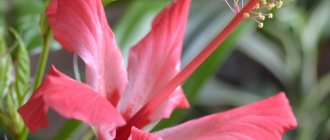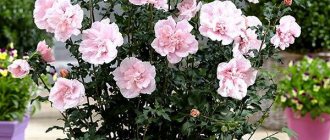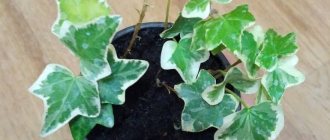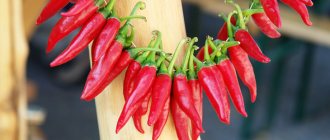Author: Natalya Category: Houseplants Published: January 24, 2019Republished: February 25, 2019Last edits: January 11, 2021
- Rules of care
- Chinese rose turns yellow
Chinese rose is a type of hibiscus brought to Europe from Asia and the Pacific Islands. Today it is one of the most beautiful large indoor plants, extremely popular in Europe, despite the many bad omens associated with Chinese hibiscus. And these superstitions were invented by the Europeans themselves. In Argentina, it is considered bad form not to have at least one hibiscus in the house. In India, Chinese roses are used to make wreaths for newlyweds, and in Hawaii and Haiti, hibiscus is a national symbol.
In our article you will find the following information:
- how to care for Chinese rose;
- how to trim it;
- how to replant;
- how to rid a plant of the problems that sometimes arise.
Planting and caring for Chinese roses
- Flowering: from spring to autumn.
- Lighting: bright diffused light, partial shade.
- Temperature: in summer – 18-20 ˚C, in winter – not lower than 15 ˚C.
- Watering: after the top layer of the substrate has dried to a depth of 2-3 cm.
- Humidity: high. Regular spraying of leaves is recommended during the hot season.
- Fertilizing: from April to September twice a month with complex mineral fertilizers alternately with organic ones. In winter, if the rose blooms, a quarter of the dose of potassium-phosphorus fertilizer is added to the soil.
- Pruning: in spring, before buds begin to form.
- Rest period: not clearly expressed.
- Transplantation: young plants are replanted annually, and starting from the age of five - once every 3-4 years.
- Reproduction: seeds and cuttings.
- Pests: thrips, aphids, whiteflies, mealybugs, spider mites.
- Diseases: chlorosis, root rot, bacterial spot, brown rot, leaf bronzing and ring spot viruses.
Read more about growing Chinese roses below.
Chinese rose plant , or Chinese hibiscus (lat. Hibiscus rosa-sinensis) is one of the most popular cultivated species of the Hibiscus genus of the Malvaceae family.
The genus of hibiscus has about two hundred species, but the Chinese hibiscus has become the most popular in home floriculture. The Chinese rose flower began its triumphant spread throughout the subtropical and tropical regions of the Earth, in which it has long and successfully taken root, from the south of China and the north of Indochina. The popularity of this plant is so great that in Malaysia, for example, the Chinese rose hibiscus, called Bungaraiya, is one of the symbols of the country, depicted on coins. In countries where the climate does not allow growing Chinese rose flowers in gardens, they are cultivated as greenhouse or indoor plants.
Types and varieties of Hibiscus for growing at home
General information about the plant:
- in nature, the height of some tree species reaches 10 m or more;
- genus from the Malvaceae family;
- there are shrubs, trees and herbaceous plants, annuals and perennials;
- in nature, Hibiscus grows in the tropics and subtropics, in Europe and America;
- large leaves, large flowers, lush crown, bright greenery, shades of petals - from white to deep red;
- A popular greenhouse and indoor plant is the Chinese rose. The photos help to understand why, when looking for an ornamental plant to decorate offices, Hibiscus rosa-sinensis is chosen with large, bright red, scarlet-tinged flowers, simple or double;
- a tree with a central trunk grows up to 2–3 m, sometimes higher, requires pruning and crown formation;
- the homeland of indoor hibiscus (Hibiscus rosa-sinensis) is the Malay Archipelago;
- Breeders have developed many interesting varieties of Chinese roses with varied shades of petals.
There are many types of Hibiscus in nature:
- Hibiscus Syrian tree.
- Trifoliate.
- Volatile.
- Chinese.
- Bolotny.
- Sudanese.
- Cosmatofruitous.
- Trifoliate.
- Terry.
Some species change the shade of their petals during different flowering periods. Previously, the Chinese rose had only bright red petals, but in recent years hybrid varieties with different bud colors have been developed: white, yellow, combined, with a bright center.
Botanical description
Indoor Chinese rose (indoor hibiscus) is an evergreen shrub or tree up to three meters high if grown in a greenhouse, and up to two meters in a normal home. The leaves of the plant are similar to birch leaves - smooth, shiny, dark green, jagged along the edge, corrugated, elongated oval in shape. Single flowers are very beautiful: narrow buds, opening, become like wide cups with a diameter of 8 to 14 cm, sometimes simple, sometimes double, depending on the variety, white, yellow, red or pink.
- Propagation of tuberous begonia. Rest period
Unfortunately, each flower blooms for only one or two days, but if the Chinese rose is cared for correctly, the flowering process can last from early spring to late autumn.
Sometimes the Chinese rose is grown at home as a standard tree. The Chinese rose is not only an excellent ornamental plant: in places where it grows naturally, the young shoots of the plant are eaten as salad, the flowers are used to make hair dye and food dye, and dry hibiscus fruits are a component of well-known medicinal teas (Hibiscus, Sudanese rose, Hibiscus tea and etc.).
Rules for successful pruning
- First you need to decide for what purpose the pruning is carried out and in what way it will be carried out. The formation of flowers in Chinese roses occurs at the tops of the stems. When the branches are pruned, the tree begins to bush more and produces more flowers. The plant is pruned in early spring; hibiscus can be trimmed a little in the fall.
- Pruning tools must be clean and very sharp. Poorly sharpened scissors and knives make the cut torn, worsen the appearance of the plant, and cut branches will take a long time to heal. Before each pruning procedure, tools are not only washed, but also disinfected. It is best to use alcohol for disinfection.
- It is best to prune hibiscus after transplantation, in spring or summer. After the procedures, caring for the rose remains the same.
- Even before you start pruning, you need to decide what shape you need. All cuts must be made at an angle of 45 degrees. Caring for a rose immediately after pruning, in order to avoid infection of the Chinese rose and for faster healing of wounds, includes sprinkling all cuts with crushed charcoal. You can use charcoal or activated carbon.
- The top of the plant is trimmed, moving away from the place where the last upper branches grow. The shoots are shortened a second time when the plant finishes flowering.
- The main rule for pruning a Chinese rose is that you can trim no more than 2/3 of all branches.
Thanks to these rules, the plant will receive minimal injuries, which will heal quickly.
How to prune hibiscus
The most popular form of hibiscus, which has a very impressive appearance, is the standard.
Forming it at home is not so easy, and after the plant takes on the desired shape, regular care is required for the branches to maintain the standard shape of the crown. But if you follow the instructions, you can get an amazing standard Chinese rose tree.
- To obtain a standard form, choose a young hibiscus. Its central shoot must be straight. Then this shoot is tied to a reliable support at the same distance and is not removed until the trunk becomes strong and stable. Growing side shoots are periodically removed.
- When the plant reaches the required height, the top of the plant is pinched. This is done to stimulate the growth of side shoots.
- After removing the top, the hibiscus will begin to actively branch. Therefore, the side branches are shortened and pinched monthly. This measure will promote the growth of dormant buds and the growth of new shoots.
- All lower shoots continue to be removed, but the upper ones are not touched. Over time, the plant will acquire the desired spherical shape.
Related article: Planting hazel grouse: soil and process, propagation and storage of bulbs
To maintain a neat decorative shape at home, careful care is required. Hibiscus is periodically trimmed, preventing the crown from growing. The haircut is done once a year in the autumn months. If you do this at another time, the hibiscus will not bloom.
You can try growing a bonsai-style tree from hibiscus. But the formation of a Chinese rose for such a plant is very difficult and time-consuming. Professional florists can produce beautiful trees decorated with many flowers.
Such plants will look very impressive and unusual in the interior. The main problem when forming a bonsai is that the hibiscus branches quickly become thick and woody.
To form a bonsai, you need to take a young plant. Its branches are tied to supports and tension devices. You need to guide their growth very carefully; this can be done using wire.
When the branches reach a length of 10–20 cm, they need to be cut off and leave no more than three leaves.
When a young plant begins to form, this may affect flowering, but for the sake of a beautiful, well-groomed form, it is worth waiting for the flowers to appear. In trees that are already formed in the bonsai style, the shoots are shortened after flowering ends.
Chinese roses withstand the procedure of pruning and shaping fairly well, so special care for them after the work is not needed. All fertilizing and watering are done as usual.
You should not be afraid to radically trim and thin out your hibiscus; on the contrary, by getting rid of old and unnecessary branches, the plant receives more nutrition for the formation of flowers and the growth of new strong shoots. Proper formation of the plant's crown will make the hibiscus the main decoration of your home or greenhouse.
Growing Chinese roses from seeds
How to sow seeds
Amateur gardeners do not really like to resort to seed propagation of perennial plants, preferring a more reliable and faster method - vegetative, but the Chinese rose, which can be easily grown both from seeds and from cuttings, due to the excellent germination of seeds and the simplicity of the procedure itself, makes it a seed The method of reproduction is exciting and quite productive. It must be said that Chinese rose seeds remain viable for six years.
At the end of February, before sowing, they should be kept for half an hour in a pink solution of potassium permanganate for disinfection, then, after washing thoroughly, soaked for a day in a solution of a growth stimulant (Epin, Zircon, Fumara) so that the liquid only slightly covers the seeds, otherwise the lack of oxygen will kill the embryos . After this, the seeds are germinated in damp gauze, unfolding it from time to time for ventilation.
Warmth and moisture are the main conditions for the germination of Chinese rose seeds, so place damp gauze with the seeds in a perforated plastic bag to allow air access to the seeds. When the shoots appear, and this can be expected in three days, they need to be planted in half-liter plastic cups with a mixture of sand, peat and ash: it is very important that the long main root of the plant grows freely, without bending or twisting. The seeds should be lightly sprinkled with earth on top, and then the cups should be covered with film or paper.
To prevent the seedlings from getting sick with blackleg, they need to be watered with a weak solution of Fundazol and in the future maintain moderation in watering. For successful growth, seedlings need bright, diffused light, but without direct sunlight.
In the photo: Chinese hibiscus blooming
Care after haircut
After the pruning procedure, the hibiscus needs to create optimal conditions.
Watering
Even in winter, watering roses cannot be stopped.
Hibiscus does not like too dry air. To make it moist, you can place a vessel with water in the room.
Rose leaves should be periodically washed in the shower to remove accumulated dust. During the period of active flower growth, the air temperature in the room should be at least 20 degrees, and in winter not lower than 16 degrees.
It is best to place a container with a flower in a room with windows facing west or east. If the room is heavily illuminated by the sun, then it is better to shade the flower from direct rays. In summer you can take the plant outside.
Top dressing
You can make fertilizers for Chinese roses yourself from available materials - shells or tea bags. But it is better to use proven methods and buy more nutritious products, such as mullein, mineral mixtures, and chicken droppings.
Organic substances include: wood ash, bone meal, compost, humus. To avoid burning the hibiscus roots, chicken manure and mullein must first be diluted with water. It is necessary to carry out such events at the dacha.
Infusions contain potassium and nitrogen. But for phosphorus nutrition it is better to use other substances (bone meal or wood ash).
If you immediately add soil and ash to the soil, they will neutralize each other’s effects and become useless.
Mineral fertilizer for hibiscus should include phosphorus and potassium. If the flower asks for more, which will be visible from the leaves (they will become sluggish), then you can spray it with a urea solution. If the flowers come to life, it means it needs nitrogen and should be sprayed again.
Shelter for the winter
- The bush is bent to the ground and covered with plastic film or other non-woven material.
- The rose is enclosed with a frame and insulated with material.
Tree varieties of roses cannot withstand severe frosts below eighteen degrees. Gardeners use the following methods on their plots:
- Cover with spruce branches or stems of other plants.
- A fence made of a wooden frame is installed and covered with non-woven insulation.
The spruce branches are placed near the bush in several layers. Snow will fall and reliably protect the plant from frost.
Covering hibiscus with other plants occurs in a vertical position. The material is tied in a bundle at the top and bottom. The result is a sheaf that will help save the rose from the cold.
The second method is to install a frame made of bars. The frame is covered with several layers of non-woven insulation. When spring comes and the frosts go away, the bush will need to be freed from insulation.
Hibiscus is an evergreen plant with colorful foliage. Even without flowers, it retains its decorative effect. If you follow all the rules for caring for it, you can enjoy luxurious flowering for several months in a row.
Caring for Chinese roses at home
Rules of care
Find a bright place for the Chinese rose near a window, but protect it from direct sunlight. If you place it in the shade, it may refuse to bloom. In the warm season, it is very advisable to take the plant out into the fresh air in a place protected from drafts and scorching sun. In summer, a comfortable temperature for a Chinese rose is 18-25 ºC and above, in winter - not lower than 15 ºC, lowering the temperature to 10 ºC can cause the plant to shed its leaves.
Growing Chinese roses requires high air humidity, so do not be lazy to spray its leaves in the summer heat and even in winter, if the room temperature is higher than necessary for the plant at this time of year. Sometimes a warm shower is useful, helping not only to saturate the leaves with moisture, but also to rid the Chinese rose of spider mites, but avoid getting drops on the flowers and buds - this can cause them to become stained and crumble. Use a long-proven method to humidify the air around the plant - a tray with wet pebbles or expanded clay, but so that the bottom of the pot with the Chinese rose does not touch the water.
Caring for a domestic Chinese rose also requires a responsible attitude to soil moisture and properly organized application of fertilizers. Watering is carried out with settled water at room temperature, and the frequency is determined by the drying of the top layer of soil 2-3 cm deep. The Chinese rose should be fed only from April to September once every two weeks with fertilizer for flowering plants or alternate complex mineral fertilizer with organic fertilizer. In winter, only potassium-phosphorus fertilizers are applied at a quarter of the indicated dose, and only if the rose is blooming.
Trimming
Many novice fans of growing hibiscus at home ask when to prune a Chinese rose. Pruning is done in the spring before transplanting the plant and before the formation of buds on it. The purpose of pruning is to increase the number of flowering shoots, to bring the beginning of flowering closer and to form a lush bush.
How to prune a Chinese rose correctly? It is necessary to remove dried, elongated and bare shoots, and shorten healthy ones by half. The cut areas are treated with garden varnish to prevent juice from leaking out of the wounds. The cut parts of the shoots can be used as cuttings for rooting.
If your goal is to rejuvenate an adult plant, cut off all shoots at a height of 15 cm from the base, provided that at least one bud remains at this point. When young shoots begin to grow, remove the weak ones so that only strong, healthy branches remain on the bush. In the summer, do another pruning, and as a result, flower buds will appear on the regrown branches only in early autumn, and you will be able to enjoy the beautiful hibiscus flowers until spring.
In the photo: How Chinese hibiscus blooms
Chinese rose in a pot
The pot for the Chinese rose is chosen to be rather cramped, because in a spacious pot the Chinese rose will only intensively grow foliage and will not bloom. Each subsequent pot should be 2-3 cm larger in diameter than the previous one. Young plants are replanted annually, and those that have reached five years of age - once every 3-4 years. Old but healthy plants are no longer replanted, but the top layer of substrate 2-3 cm thick is renewed every year.
- Azistasia: planting and care, types and varieties
In the photo: Chinese rose flower
Transfer
How to plant a Chinese rose? First, prepare a mixture of turf, leaf soil (one part each), humus soil and sand (half part each), and it is advisable to add one part of peat soil to the mixture for young plants. And, of course, a layer of expanded clay, broken brick or clay shards must be placed at the bottom of the pot so that moisture does not stagnate in the roots of the plant. How to replant a Chinese rose without damaging the plant's root system? Of course, by transferring a plant from an old pot to a new one.
Chinese rose after flowering
As such, the Chinese rose does not have a dormant period, at least not a pronounced one. But if there is a need to give the plant a rest, it is put into a dormant state, gradually reducing watering to the required minimum. As soon as the leaves fall from the plant, it is cut off, leaving 15 cm of shoots from the root, and placed for the winter in partial shade and coolness at a temperature of 10-12 ºC.
How to grow eustoma at home and in the garden
Water the Chinese rose from time to time, after which the top of the pot is covered with a mat or paper bag to retain moisture in the soil longer. In the spring, the pot with the plant is exposed to bright, diffused light and watering is gradually increased to the usual rate to stimulate the growth of young shoots.
In the photo: Beautiful Chinese rose flower
Advice from experienced flower growers
Flower growers recommend a form for pruning in the form of a trunk. It is not easy to form.
Article on the topic: Cocklebur grass: medicinal properties and contraindications, photos, planting and care, cultivation
Forming a rose bush with a trunk
Chinese rose: pruning and forming a bush into a standard - step-by-step instructions:
- To obtain a standard form, choose a young hibiscus. The shoot in the center should be upright.
- A support is placed nearby, to which the hibiscus is tied. It is left until the trunk becomes stronger.
- Side branches must be cut off.
- Remove the top after the flower reaches the height required by the grower.
- Trim the lower shoots until the hibiscus acquires a spherical shape (needs 2-3 months).
Then proper care is required to maintain its shape: periodically you need to pinch it so that the hibiscus looks like a bush.
In autumn, flower growers advise pruning: this will allow the Chinese rose to bloom.
The procedure for pruning a Chinese rose is quite simple; it cannot be neglected, since the plant needs it: if you do not prune the hibiscus, it will not only look untidy, but will also not be able to bloom profusely.
Chinese rose propagation
As we have already found out, the Chinese rose reproduces well from seeds. How to propagate Chinese roses vegetatively, for example, by cuttings? It is best to use cuttings of Chinese roses left after spring pruning of the plant for rooting. Treat the cuttings with a growth stimulator - Kornevin or Heteroauxin - and place the cuttings in water to grow roots or plant them in a mixture of sand and peat, covering the top with a glass jar.
Rooting will occur within three to four weeks, after which the cuttings are planted in Chinese rose soil and pinched to stimulate tillering. Rooted spring cuttings in good light may even bloom in a couple of months. For cuttings, you can also use apical cuttings with two or three internodes, cut in July or August.
In the photo: Pink hibiscus
How to root?
There are 2 ways to root a propagated plant - in water or in soil.
In the soil
Before planting hibiscus in a pot with nutrient soil, wait until strong roots appear on the cut cuttings.
- To do this, they are planted in a cup, which is filled 1/3 with soil (2 parts of leaf soil and 1 part of peat and sand).
- Before planting, each cutting is dipped in heteroauxin powder.
- After planting, the soil is topped up and compacted around it.
Hibiscus cuttings produce roots in 25-30 days. Rapid root formation is guaranteed for those who make a mini-greenhouse or greenhouse from improvised materials. Using a mini-greenhouse, they maintain high humidity and temperature around 22-25⁰C.
In water
- To root the cuttings in water, take a dark glass container.
- Warm but settled water is poured into it.
- Add 2 tablets of activated carbon to it, add a few drops of fertilizer so that the cutting receives the necessary nutrition during root formation.
- The container is placed on a well-lit, but not in direct sunlight, windowsill.
Important! A plant with 5-7 cm roots and 1-2 new leaves is transplanted into a pot.
Pests and diseases
Among the pests that pose a danger to the Chinese rose are thrips, aphids and spider mites, and the invasion of these insects usually occurs as a result of your violating the rules of caring for the plant, and most often the main reason is too dry air. Place the plant on a tray with a wet stone, start spraying the leaves with settled water at room temperature to eliminate conditions favorable for the life of these insects; Treat the plant twice with an interval of two weeks with an infusion of hot pepper with soap that destroys insects, and if the infestation is too strong, you will have to use the same treatment with Actellik solution at the rate of 15 drops per liter of water.
Sometimes flower growers complain that the leaves of the Chinese rose turn yellow . The reason for this may be a disease such as chlorosis, which occurs due to the increased content of calcium and chlorine in the water used for irrigation. The water must be settled and, before watering, iron chelate must be added to it in the amount specified in the instructions.
In the photo: How hibiscus blooms
Chinese rose turns yellow
If you water with settled water at the required temperature, but for some reason the leaves of the Chinese rose still turn yellow, the reason for this may be too much moisture in the soil for a long time. If there are not many yellow leaves, simply reduce watering, you can even replace it by spraying the leaves for a while. But if the leaves turn yellow en masse, you will have to replant the plant in new soil, inspecting the root system and removing rotten roots.
How to grow hibiscus in the garden - advice from experienced gardeners
Another reason why a Chinese rose turns yellow may be insufficient light for normal plant growth - in this case, real leaf fall can be observed. There are other reasons why hibiscus turns yellow.
Chinese rose falls
Chinese rose leaves also fall due to drafts and sudden temperature changes. If you want to save the plant, immediately eliminate deficiencies in care, because this is not at all difficult. But do not sound the alarm if the plant loses only a few leaves - this is quite normal for a deciduous plant.
Chinese rose dries
If you water a plant correctly and its leaves still dry out, this may be the plant's reaction to a change in location. The leaves of a frozen plant also dry out. Give him time to recover and warm up.
In the photo: Yellow hibiscus
Chinese rose withers
This is due to poor watering of the plant. Or it has not yet recovered from the transplant. But the worst thing is if the problem is in the roots: carefully clean the roots from the soil, soak for half an hour in a weak solution of potassium permanganate and transplant into a small pot with light soil (add vermiculite to the usual soil for hibiscus) - maybe these measures will save your plant.
- Why Ficus Benjamin falls off - what to do
Why doesn't the rose bloom?
There are also several reasons why a Chinese rose does not bloom, but most often this is due to an excess of nitrogen fertilizers in the soil, especially if the plant looks healthy and is abundantly covered with foliage.
The plant also does not bloom:
- when there is not enough light for him;
- if you do not moisturize it enough during the active growing season;
- in case of wintering in a room that is too warm.
In order for the Chinese rose to bloom, you need to eliminate the listed reasons and correct other possible errors in caring for the plant.
Chinese Rosan's disease
Sometimes, for no apparent reason, the flower begins to hurt. This is expressed in different ways, and the reasons can also be completely different. Let's see which of them are the most basic.
Falling buds
This happens when the plant has a nutritional deficiency. It happens that there is simply not enough moisture, especially if the humidity in the apartment is low or when the flower is located next to heating devices.
Yellowing of leaves
There can be quite a lot of reasons. Let's list the main ones.
- There is not enough moisture. If there is a dry and hot summer outside, then you need to constantly water the Chinese rose. If necessary, then daily. The soil in the flowerpot should not dry out completely. Be sure not to forget about spraying.
- Pouring a flower. During the winter months, the room can be chilly. When a flower is watered too often, the pot ends up in a swamp, which has a very negative effect on the condition of the root system.
- Too much sun. To prevent the leaf plates from suffering from fading and burns that result from exposure to the hottest and brightest rays of the sun during the day, place the pot correctly. The sun should hit the plant in the morning and evening hours.
- Little sun. Let's remember botany, where attention is focused on the fact that plants produce chlorophyll only in the light. Hibiscus is no exception. When there is too little sun, the leaves turn yellow and fall off until only a few remain.
- The temperature is not suitable. The most comfortable temperature for this flower is from +18 to +30 degrees Celsius. When the room is very cold or, conversely, stuffy and hot, the leaves of the plant begin to turn yellow and then fall off. Don't forget that the Chinese rose is a tropical guest.
- Harmful insects. Rosans can especially be plagued by spider mites, which look like very small crabs. The disease is expressed in dirty spots on yellow leaves and cobwebs between the leaf blades. If you notice signs of damage, immediately begin treating the flower with insecticides or soap solution.
- Wrong fertilizers. Fertilizing with a high content of phosphates is not suitable, as is the abuse of nitrogen. It is better to underfeed than to overfeed. You can do harm to the flower, not benefit.
No flowering
If the crown is thick and the leaves are green and bright, then there was too much nitrogen. Maybe the flower was hot in the winter season, and the flower buds were not formed.
Chinese rose - signs
The popularity of hibiscus sometimes does it a disservice: various fables are told about this flower, often mutually exclusive.
For example, some sources claim that the Chinese rose attracts many admirers to the house where a woman lives, while others also persistently warn against the destructive influence of hibiscus on the relationship between spouses and call the Chinese rose “husband.”
Some believe that the Chinese rose is a flower of death, since its untimely flowering predicts the imminent death of a person close to the owners of the plant. And if the leaves of a Chinese rose fall off, this is a prognosis for the imminent serious illness of one of the household members.
It is noteworthy that all these negative opinions exist only in our country, while the rest of the world perceives the Chinese rose simply as an attractive and unassuming houseplant.
In the photo: Pink hibiscus flowers
Indoor hibiscus
The hibiscus plant was well known back in Ancient Greece. However, at that time mallow was called this name. Hibiscus is known today as the Chinese rose. The plant is loved and revered on many islands that are located in the Pacific Ocean. For local women, hibiscus inflorescences are an exquisite hair decoration. Apparently, this tradition gave the name to the plant, since in translation “hibiscus” means “flower for beautiful ladies.”
Malaysians revere the hibiscus as their national flower; each petal of the inflorescence symbolizes an Islamic commandment. Residents of India and China treat this handsome man with respect. This plant is credited with miraculous properties - Easterners believe that hibiscus protects the home from evil intentions, helps business people succeed, and also gives strength to cope with depression.
Where can you keep a Chinese rose in your home?
According to Feng Shui, the only rose that cannot be kept at home is the Chinese rose, because it has the ability to absorb energy. It’s up to you to believe it or not, but if you don’t believe in omens and, no matter what, you want to grow a Chinese rose in your home, who can stop you from doing so? Take precautions and do not keep the Chinese rose in the bedroom or in the nursery, but place this large plant in the living room, where it will not become a hindrance, but, on the contrary, will serve as an excellent decorative element and purify the air in your home, absorbing harmful impurities from it and filling with oxygen.











